I'm lucky enough to live in one of the most biodiverse parts of Ontario in the Frontenac Arch; Right in the middle of the transition between the southern deciduous forests and agricultural fields and the mixedwood forests of the Canadian Shield. I had a busy day on Saturday exploring and I wasn't disappointed!
I started by leading a group of folks from the Quinte and the Prince Edward County Field Naturalists Clubs to one of eastern Ontario's best kept secrets - the
Napanee Limestone Plain Important Bird Area. This place is basically an eastern version of
Carden Alvar. We met in Napanee then headed for our first stop just south of Newburgh:
 |
| Alvar south of Newburgh |
As you can see, it's beautiful alvar habitat with thin soils over limestone with scattered trees and shrubs. Typical alvar plants like Prairie Smoke put on a great show as did this provincially rare Balsam Ragwort in full bloom:
 |
| Balsam Ragwort |
The plants didn't disappoint and neither did the birds. We saw all of our target species: Grasshopper Sparrow, Clay-colored Sparrow, Wilson's Snipe, Upland Sandpiper, Eastern Meadowlark, Bobolink, and of course, Loggerhead Shrike. The Loggerhead Shrike is the "trigger species" for the IBA status here with usually about 1/3 of the eastern Canadian population breeding here.
 |
| Phone-binned shot of an Upland Sandpiper |
After lunch I headed to Charleston Lake Provincial Park to help with the afternoon leg of the annual Butterfly and Dragonfly count. Butterflies were slow as we seemed to be a bit late for the early species and too early for the next wave this year but dragonflies put on a good show and there were a few other highlights too.
The rarest sighting of my afternoon was probably the young
Gray Ratsnake that coiled up on the path in front of me - the park is one of the best places in Ontario to see this rare snake. My two butterfly highlights were probably as follows:
 |
| Juniper Hairstreak |
 |
| Baltimore Checkerspot caterpillar |
As I said earlier, dragonflies were out in good numbers and in the couple hours I was out I managed to find 26 species including some provincially rare species like Harlequin Darner, Cyrano Darner, and Lilypad Clubtail.
 |
| male Harlequin Darner |
 |
| Springtime Darner |
 |
| Lilypad Clubtail |
Add in a couple of Cerulean Warblers and the Brewster's Warbler (hybrid) that I also had and it was really just a typical day in one of the richest parts of Ontario.



















































